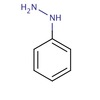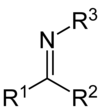Chapter 6 - Carbohydrates Flashcards
Describe Ruff degradation
It decreases the chain of an aldose by decarboxylation. The aldehyde is first oxidized into carboxylic acid and deprotonated by 1) Br2, H2O, 2) Ca(OH)2, H2O. Then the carboxylic acid is oxidized into carbon dioxide by peroxide in the presence of a ferric cation catalyst (H2O2, Fe3+). Carbon dioxide leaves and decreases the chain length by one carbon.
D-Mannose structure
D-mannose: man’s gun (middle and index finger of right hand as barrel)
L-mannose: man’s gun (middle and index finger of left hand as barrel)

When nitric acid (HNO3) is reacted with an aldohexose, what is the product? What is the purpose of using this reaction?
Nitric acid is an oxidizing agent that can oxidize both terminal carbons of an aldohexose (aldehyde and alcohol) into carboxylic acids. This is a test for optical activity.
What makes the strucure of cellulose so uniform?
It is linear and exhibits hydrogen bonding.
What is mutarotation?
conversion from one anomer into the other
How does the chirality of the penultimate carbon in carbohydrates determine D/L status?
If the penultimate carbon has R-stereochemistry it will be the D-isomer. If it has S-stereochemistry it will be the L-isomer.
What is the difference between ketoses and aldoses?
ketoses = ketone sugars
aldoses = aldehyde sugars
In naming disaccharides, how do the component names differ?
The left sugar is considered a subtituent on the right sugar, so it gets an “osyl” suffix, while the right sugar gets an “oside” suffix.
To form a cyclic sugar, which portions undergo reaction in the straight chain form? What is formed at the anomeric carbon?
A hydroxyl group attacks the carbonyl carbon yielding a hemiacetal/hemiketal.
How do the hydroxyl groups on each side of a Fischer projection relate to their up/down position on a Haworth projection?
If they are on the right, they will be down. If they are on the left, they will be up (“downright uplefting”).
D-Fructose structure
D-Fructose: ketose of glucose

Basic formula of monosaccharides
CnH2nOn
What is the purpose of the Tollen’s test and what does it use?
It uses silver ion reacted with an oxidizable sugar (either an aldose or ketose). The silver ion is reduced to silver metal and forms a silver mirror on the walls of the reaction vessel. The sugar is oxidized. If it is an aldose, it will oxidize quickly (positive test). If it is a ketose, it will take a bit of time.
D-Galactose structure
D-galactose: C-4 epimer of glucose

D-Ribose structure
D-ribose: ribose is all-right
L-ribose: ribose is all-left

What is a nucleoside?
nitrogenous base + sugar
Is glycolysis oxidative or reductive?
oxidative
What is a six-membered carbohydrate ring called?
pyranose





